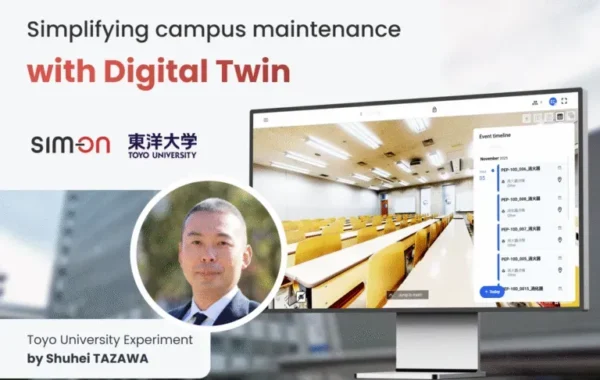Background and Obstacles
Silesian University of Technology stands as a premier technical institution in Poland, managing a vast campus comprising numerous educational buildings, research laboratories, and administrative structures. Overseeing such extensive academic infrastructure presents considerable challenges. Facility maintenance demands continuous technical oversight, systematic inspection planning, and seamless integration of data from multiple building automation systems (BMS). Previously, the university depended on conventional documentation methods—physical blueprints, 2D technical drawings, and fragmented spreadsheet systems.
This traditional methodology created coordination difficulties: fault identification consumed excessive time, current equipment status information remained unavailable, and operational cost management faced obstacles. Consequently, infrastructure data became scattered across various departments and file systems, leading staff to waste valuable time searching for information rather than implementing solutions.
Seeking to optimize these workflows, Silesian University of Technology embraced cutting-edge Digital Twin technologies. The initiative took inspiration from Tokyo’s Toyo University, where campus digital twin implementation dramatically reduced failure response periods and decreased building management expenses.
Research by Professor Shuhei Tazawa from Toyo University’s Faculty of Architecture demonstrated that air-conditioning system repair times decreased by 55%, resulting in faster infrastructure restoration and reduced operational losses. Motivated by these achievements, university leadership committed to real estate digitization. The institution collaborated with SIMLAB—experts in Digital Twin technology, IoT system integration, and Facility Management solutions—to create a comprehensive digital campus representation.
Digital Twin Implementation
The cornerstone technology proved to be SIM-ON, functioning as the digital twin for selected Silesian University facilities. SIM-ON represents an advanced infrastructure management platform utilizing 3D building scans as interactive interfaces for gathering and displaying critical facility information.
Initial implementation at EHTIC (European HealthTech Innovation Center) established data management protocols, user onboarding procedures, and iterative development methodologies that became templates for additional university structures.
The platform operates through virtual 3D models created using Digital Twin technology—comprehensive interior building scans navigable through computer interfaces. These 3D models transcend mere visualization, serving as centralized information repositories. Users (facility administrators, technical personnel) can access virtual models and immediately retrieve relevant data linked to specific rooms or equipment.
SIM-ON consolidates diverse facility management components including:
Maintenance and Inspection Scheduling: Building installations maintain defined periodic check timelines tied to specific 3D model locations and devices. The system automatically generates inspection reminders, and users can view service history by clicking model objects.
Technical Documentation Repository: Engineering drawings, operation manuals, installation schematics, and acceptance protocols—previously stored in physical binders or scattered files—are digitized and linked to appropriate model locations. Clicking the virtual boiler room provides instant access to heating system schematics or boiler documentation.
Issue Reporting and Communication: Staff report failures or maintenance requirements directly through 3D models by selecting rooms or devices and adding fault descriptions. Information automatically reaches relevant Facility Management teams for prioritization and tracking. All communications remain recorded for status visibility.
These features operate within a unified 3D environment. Instead of switching between scheduling software, documentation folders, and separate ticketing systems, staff access everything through the campus digital twin. Interactive campus maps serve as portals—selecting buildings from map views allows users to “enter” digital interiors containing contextual data.
Implementation Phases
Maximizing digital twin potential required dividing the Silesian University project into sequential stages, enabling progressive milestone achievement, continuous learning, and solution customization. Main phases included:
Facility Inventory and Digital Capture
Initial steps involved detailed scanning of selected campus buildings using Matterport cameras to create realistic 3D interior models capturing rooms, corridors, equipment, and fixtures. The process resembled virtual tour creation—operators moved through spaces while devices recorded complete 360° depth images. Scans produced accurate 3D models accessible via web browsers. SIMLAB teams built interactive campus maps featuring scanned buildings prepared for data integration.
Platform Deployment and Training
Following model completion, SIM-ON launched with user handover. SIMLAB collaborated closely with university administration to customize system configurations for campus requirements. Data structures were defined, and initial information packages uploaded—inspection schedules, digitized technical documentation, and maintenance contact lists. Parallel training sessions and workshops prepared users, covering basic 3D navigation through advanced features like report generation and ticket filtering.
Integration, Development, and Expansion
After successful initial implementation, collaboration entered growth phases. Plans include expanding platforms to additional campus buildings, with goals of covering all key university facilities. Each new 3D model undergoes similar data integration processes, becoming part of central campus maps. Concurrent work integrates SIM-ON with existing building management systems and IoT sensors monitoring utility consumption.
Results and Benefits
Early SIM-ON usage months delivered measurable benefits:
40% faster failure response times through immediate access to consolidated facility information
Complete visual asset inventory serving as virtual resource catalogs
Centralized single-environment management replacing multiple system juggling
Accelerated inspections and audits through digitized schedules and protocols
Optimized maintenance costs via better asset control and technical condition monitoring
Intuitive workflows improving staff operations through user-friendly 3D interfaces
Future Outlook
SIM-ON deployment at Silesian University demonstrates successful academia-business collaboration creating innovative solutions. The university’s infrastructure expertise combined with SIMLAB’s technology and commercial experience established new campus management standards. Digital twin implementation has streamlined operations, reduced response times, and organized facility information systems.
This transformation positions Silesian University as a Polish public university pioneer in Digital Twin infrastructure management, proving traditional academic facilities can successfully enter digital building operations eras.
**#DigitalTwin #SmartCampus #FacilityManagement #UniversityTechnology #InfrastructureManagement #3DModeling #IoTIntegration #SIMLAB #SilesianUniversity #CampusInvation






